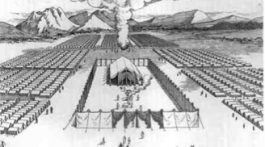Sabbath School Lesson for July 13-19, 2024
Overviews of Lesson 3, Controversies
Memory Text: “And He said to them, ‘The Sabbath was made for man, and not man for the Sabbath. Therefore the Son of Man is also Lord of the Sabbath.’ ” Mark 2:27, 28 NKJV
Before Jesus made the astonishing statement about the Sabbath being for man in Mark 2:27, religious leaders expressed alarm about His healing on the Sabbath and about His disciples plucking grains of wheat to eat while walking through a field on the Sabbath. Both behaviors ran counter to prescribed ways they had determined the Sabbath was to be kept.
Like most of us, Jesus encountered controversy during the time He spent on earth. It’s helpful to see how He handled the daily back-and-forth disagreements that interrupted His ministry. Both His church family and close relatives had concerns about the way He chose to live and serve God. It’s helpful to know how Jesus patiently countered these critics, using their claims as story links that helped reinforce His message. His thought-provoking questions were also meant to pierce the heart and change minds.
The second and third chapters of Mark provide us with insight into the nature and role of the Messiah. It was obvious that His critics, after years of false ideas and relying on tradition, were the slowest to understand Him.
These two chapters will open our eyes and help us see how…
- Sunday: Healing a Paralytic–Jesus forgave the sins of a paralytic lowered through the roof.
- Monday: Calling Levi and the Question of Fasting–Jesus wasn’t afraid to eat and socialize with tax collectors like Matthew.
- Tuesday: The Lord of the Sabbath–By healing someone on the Sabbath, Jesus showed us that it was acceptable to help others on that day.
- Wednesday: Sandwich Story: Part 1–Scribes and Pharisees thought Jesus was of the devil.
- Thursday: Sandwich Story: Part 2–Jesus’ mother and brothers thought He was crazy.
Sunday: Healing a Paralytic
Many teaching nuggets are in the heartwarming story about a paralytic, who was lowered through the roof of a crowded house to be healed. But one aspect of the story proved to be problematic for Jesus at the time. Jesus, understanding the sin-sick paralytic’s spiritual need, first forgave him, relieving his guilt-ridden heart.
This was utter blasphemy in the thoughts of some in the crowd. Only God could forgive sin, they rightfully claimed. Jesus, reading their cynical doubts about who He was, called them out and proceeded to do something much greater. He told the paralytic to get up and walk; which he did, amazing them all.
By making someone walk by the power of God, they should have had confidence that this itinerant preacher was the Messiah. Being God in the flesh, He also had the power to forgive sin.
Bible Verses to Explore:
Mark 2:1-12 and Psalm 103:3
- How was this healing problematic for Jesus?
- How did it prove the divinity of Christ?
Mark 2:8
- Besides forgiving and healing the paralytic, what other indication is given in the story that Jesus was actually God in the flesh?
Micah 6:8
- Why were the religious leaders so blind about who Jesus was? What three things did they lack?
Monday: Calling Levi and the Question of Fasting
More controversies erupted when the religious leaders noticed that Jesus was associating with known sinners. The fact that Matthew Levi, the son of Alphaeus, was a tax collector, automatically made him guilty of theft. Many tax collectors of the time certainly overcharged people, in order to make themselves rich.
It was troublesome that Jesus had actually called Matthew, a tax collector, to be one of His disciples. And to make matters worse, He chose to dine with him and other tax collector friends–something that was forbidden by Jesus’ critics. When questioned about this “unholy” behavior, Jesus explained that His purpose was to save sinners, much the same as a doctor heals sick people. Shouldn’t a doctor go where sick people are?
There was also the question of fasting. Jesus’ disciples didn’t fast, as the Pharisees, and even John’s disciples, did. But Jesus pointed out that those with the bridegroom certainly wouldn’t fast at the wedding feast. There would be plenty of time for fasting, Jesus added, when the Bridegroom was no longer with them–speaking of His coming death.
Bible Verses to Explore:
Mark 2:13-17
- How did Jesus justify eating and befriending sinners?
- How and why should we associate with secular, worldly people, and those of other faiths?
Mark 2:18-20
- Why didn’t the disciples need to fast?
Mark 2:21-22
- How did this culturally-driven illustration help them understand that Jesus, the “new”, did not fit into their “old” ideas and practices?
- What was “new” about Jesus, and what was “old” about their traditions?
Tuesday: The Lord of the Sabbath
Jewish tradition determined that there were 39 kinds of labor prohibited on the Sabbath. One of them was plucking, or harvesting, grain. Jesus defended His disciples for doing this on the Sabbath by reminding them of what David’s men did when they were hungry. See Mark 2:23-28.
But later, the scribes and Pharisees began to question Jesus’ healing on the Sabbath after healing a man’s withered hand in the synagogue. People were drawn so much to His miracles of healing that they thought this would be an excellent way to make Jesus look bad to the people and question His authority.
Jesus, however, countered their argument with the question, “Is it lawful on the Sabbath to do good or to do evil, to save life or to kill?” (Mark 3:4). Matthew’s account includes that Jesus also asked them, “What man is there among you who has one sheep, and if it falls into a pit on the Sabbath, will not lay hold of it and lift it out?” (Matthew 12:11).
Besides using story illustrations, these incidents show that Jesus also used emotionally-piercing questions to handle controversy.
Bible Verses to Explore:
Mark 2:23-28
- What did the disciples’ behavior actually tell us about who Jesus was?
- Why were the religious leaders not getting the message about Christ’s divinity?
Mark 3:1-6
- What proved that there were some hard-hearted people in the crowd when Jesus healed the man’s hand, and how did Jesus deal with them?
Wednesday: Sandwich Story, Part 1
Jesus chose twelve disciples to be His closest companions and began mentoring them. Multitudes had begun to throng Jesus to be healed and taught by Him. Jewish religious leaders, probably jealous of His popularity, made some blistering remarks about how Jesus was casting out demons. They said He was using the power of Satan to cast out demons.
Jesus wisely countered their false charge with the question, “How can Satan cast out Satan?” (Mark 3:23). And why would he? He illustrated this ridiculous claim with the comparison of a divided kingdom or house. If it is divided, it surely won’t last long. It actually can’t stand, Jesus said.
Then Jesus seems to have been referring to Himself, when He told how a thief, robbing a strong man’s house must first bind the strong man, before he can complete his mission of plunder (Mark 3:27). Jesus was sent to bind Satan, so He could “steal” His people away from Satan’s possession.
Jesus closed His remarks by warning them that by blaspheming the Holy Spirit, by asserting that His Spirit was actually the spirit of Satan, they were committing a sin that can’t be forgiven (Mark 3:29). They virtually were closing themselves off and not listening to the Holy Spirit, whose role was to convict them of sin.
Bible Verses to Explore:
Mark 3:20-27
- Explain what Jesus meant by the kingdom or house not standing and about the strong man being bound.
- Why did Jesus use these illustrations?
Mark 3:28-30
- How did Jesus’ description of the unpardonable sin become the “meat” of the sandwich here, the heart of the story?
- How do we know if we’ve committed the unpardonable sin, and why is it something that can’t be forgiven?
Thursday: Sandwich Story, Part 2
In the first story (the first slice of our sandwich bread), we saw how the scribes, Jesus’ own people, thought He was of the devil. But after He addressed this problem by talking about a house divided, we find that His own family also had concerns about His ministry.
Mark 3:20, 21 provided one reason Jesus’ mother and brothers came to see Him. The crowds had become so great that Jesus and the disciples didn’t even have time to eat. They reasoned that there must be some mental issues (craziness) that accounted for Jesus’ unusual behavior.
The family had probably heard about the charges being made by religious clerics and were also worried about their family’s reputation. It was obvious that they did not understand His mission and were not in tune with God’s will at this time.
It appeared that Jesus’ own family was divided, so Jesus explained the situation by referring to His real family as those who were doing the will of God. This redefinition of family has caused church members worldwide to refer to each other as “brother” and “sister”. We know that when our own loved ones don’t understand our faith, just like Jesus’ family, we have others in our church family who do.
Bible Verses to Explore:
Mark 3:20-21, 31-35
- Who does Jesus claim as His real family?
- Why is this comforting to church members today?
Isaiah 53:3
- How was this verse a prophecy of how Jesus’ ministry would be seen by people?
- How does this give you comfort, when you are facing rejection of family and friends because of your faith?
Friday: Final Thoughts
One point we may have missed in our study of Mark 2 and 3 was the ever-changing location of Jesus’ ministry. He was not confined to teaching in the synagogue. He served God wherever the people were. He was found outside in rural areas around the Sea of Galilee, in the homes of His followers, and in the business office of a tax collector. He even delivered a message after walking through a field of grain. People noticed Him in many settings, as He compassionately shared with the world what God was like.
We, too, must think of duty to God as often being outside our faith community. There’s more to being a Christian than what happens at church. Gathering together with fellow believers does strengthen our ability to serve, but our witness must permeate all areas of life. Family members, friends, and co-workers must also be able to sense our connection with God as we go about our daily tasks, despite controversies that are sure to come our way.
Next Week: Parables
To read the Sabbath School Lesson Quarterly and see more resources for its study, go to









